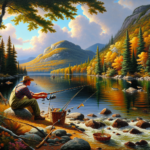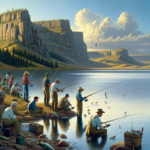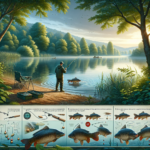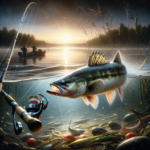Fishing in Vermont: Lakes, Rivers, and Streams

Introduction
Did you know that Vermont is home to over 800 lakes and ponds, and more than 7,000 miles of rivers and streams? This makes it a paradise for anglers of all skill levels. Whether you’re a seasoned pro or a weekend hobbyist, fishing in Vermont offers a diverse and rewarding experience.
In this article, we will explore the various aspects of fishing in Vermont, including the best techniques, species to target, top fishing spots, and essential gear. We will also cover seasonal considerations, local events, and important safety and conservation practices. By the end of this guide, you’ll be well-prepared to make the most of your fishing adventures in the Green Mountain State.
Fishing in Vermont matters not just for the thrill of the catch but also for the opportunity to connect with nature, enjoy the state’s stunning landscapes, and contribute to local conservation efforts. Whether you’re looking to find the best fishing spots, master a new technique, or prepare for an upcoming event, this guide has you covered.
Background/Context
Historical or Cultural Significance
Fishing has been an integral part of Vermont’s history and culture for centuries. Native American tribes, such as the Abenaki, relied on the state’s abundant waterways for sustenance. European settlers continued this tradition, and fishing became a popular recreational activity in the 19th and 20th centuries. Today, fishing remains a beloved pastime, contributing to Vermont’s tourism and local economy.
Geographical Overview
Vermont’s diverse geography includes the Green Mountains, rolling hills, and fertile valleys, all of which contribute to its rich aquatic ecosystems. The state’s climate features four distinct seasons, each offering unique fishing opportunities. Vermont’s waterways are home to a variety of fish species, supported by clean, cold waters and well-managed habitats.
Key Points/Details
Fishing Techniques
Technique Overview
Vermont offers a range of fishing techniques, including fly fishing, spin fishing, and ice fishing. Fly fishing is particularly popular in the state’s rivers and streams, while spin fishing is commonly used in lakes and ponds. Ice fishing is a favorite winter activity, allowing anglers to fish through the ice on frozen lakes.
When and Where to Use
Fly fishing is best suited for rivers and streams, particularly during the spring and fall when insect hatches are most active. Spin fishing can be effective year-round in lakes and ponds, with early morning and late evening being prime times. Ice fishing is typically done from December to March, depending on ice conditions.
Recommended Gear
- Fly Fishing: 9-foot, 5-weight rod, floating line, and a variety of dry flies, nymphs, and streamers.
- Spin Fishing: Medium-action spinning rod, 6-10 lb test line, and a selection of lures such as spinners, crankbaits, and soft plastics.
- Ice Fishing: Ice auger, short ice fishing rod, tip-ups, and live bait such as minnows or worms.
Species Information
Species Overview
Vermont’s waters are home to a variety of fish species, including brook trout, rainbow trout, brown trout, largemouth bass, smallmouth bass, northern pike, and walleye. Each species has its own habits, preferred habitats, and seasonal behaviors.
Best Practices
To successfully catch trout, focus on cold, clear streams and rivers with plenty of cover. Use small, natural-looking flies or lures. For bass, target lakes and ponds with structure such as submerged logs or weed beds. Use larger lures that mimic prey fish. Northern pike and walleye are often found in deeper waters; use live bait or large lures to attract them.
Location Information
Top Fishing Spots
- Lake Champlain: Known for its diverse fish population, including bass, pike, and walleye. Access points include public boat launches and state parks.
- Battenkill River: Famous for its wild trout population, this river offers excellent fly fishing opportunities. Access points are available along Route 7A.
- Lake Bomoseen: Vermont’s largest lake entirely within the state, offering great fishing for bass, pike, and panfish. Public access is available at Bomoseen State Park.
Regulations and Licenses
Anglers in Vermont must have a valid fishing license, which can be purchased online or at local retailers. Regulations vary by water body and species, so it’s important to check the Vermont Fish & Wildlife Department’s website for the latest rules. Common regulations include catch limits, size limits, and seasonal restrictions.
Seasonal Considerations
Seasonal Variations
Fishing conditions in Vermont change with the seasons. Spring and fall are prime times for trout fishing, as water temperatures are cooler and insect activity is high. Summer offers excellent bass fishing in lakes and ponds, while winter is the season for ice fishing.
Best Times to Fish
The best times to fish in Vermont are early morning and late evening, when fish are most active. Seasonal peaks include spring and fall for trout, summer for bass, and winter for ice fishing. Always check local conditions and weather forecasts before heading out.
Events and Tournaments
Event Overview
Vermont hosts several fishing events and tournaments throughout the year. Notable events include the Lake Champlain International Father’s Day Derby, the Vermont Trout Unlimited Fly Fishing Festival, and various ice fishing derbies.
Preparation Tips
To prepare for a fishing event, make sure your gear is in good condition and suited to the target species. Practice your casting and retrieval techniques, and familiarize yourself with the event rules and regulations. Arrive early to secure a good spot and be prepared for changing weather conditions.
Tips and Best Practices
General Tips
- Always check local fishing reports for the latest conditions and fish activity.
- Use natural-looking baits and lures that match the local forage.
- Practice catch and release to help sustain fish populations.
Avoid Common Mistakes
- Don’t overlook the importance of stealth; fish can be easily spooked by noise and movement.
- Avoid using gear that’s too heavy or too light for the target species.
- Don’t ignore local regulations; always check for updates before fishing.
Advanced Techniques
- Master the art of reading water to identify fish-holding areas.
- Learn advanced casting techniques, such as roll casts and double hauls, for fly fishing.
- Experiment with different retrieval speeds and patterns to trigger strikes.
Gear and Equipment Recommendations
Essential Gear
- Fishing rod and reel suited to your target species and technique.
- Appropriate line, leaders, and tippets.
- A variety of baits and lures.
- Fishing license and any required permits.
Optional Gear/Upgrades
- Polarized sunglasses to reduce glare and see fish more clearly.
- Waders and wading boots for river and stream fishing.
- Fish finder or depth sounder for locating fish in lakes and ponds.
Where to Buy or Rent
Local shops such as The Fly Rod Shop in Stowe and Orvis in Manchester offer a wide range of fishing gear and equipment. Online retailers like Bass Pro Shops and Cabela’s also provide extensive selections. Some local shops may offer gear rentals, particularly for fly fishing and ice fishing.
Safety and Conservation
Safety Tips
- Always wear a life jacket when fishing from a boat or on ice.
- Be aware of weather conditions and be prepared for sudden changes.
- Carry a first aid kit and know basic first aid procedures.
Conservation Practices
- Practice catch and release to help maintain healthy fish populations.
- Respect local wildlife and habitats; avoid disturbing nesting areas and spawning beds.
- Follow all local regulations and guidelines to ensure sustainable fishing practices.
Planning Your Trip
Accommodations
Vermont offers a range of accommodations near popular fishing spots, from rustic cabins and campgrounds to cozy bed-and-breakfasts and luxury resorts. Notable options include Basin Harbor on Lake Champlain, The Equinox in Manchester, and various state park campgrounds.
Travel Tips
Vermont is easily accessible by car, with major highways such as I-89 and I-91 providing convenient routes. Burlington International Airport offers flights from major cities, and Amtrak provides rail service to several Vermont towns. Renting a car is recommended for exploring remote fishing spots.
Additional Activities
In addition to fishing, Vermont offers a wealth of outdoor activities, including hiking, biking, and kayaking. Cultural attractions such as the Shelburne Museum and Ben & Jerry’s Factory Tour provide fun for the whole family. Don’t miss the chance to explore charming towns like Stowe and Woodstock.
Frequently Asked Questions (FAQs)
Do I need a fishing license in Vermont?
Yes, a valid fishing license is required for all anglers aged 15 and older. Licenses can be purchased online or at local retailers.
What are the best times of year to fish in Vermont?
Spring and fall are ideal for trout fishing, summer is great for bass, and winter is perfect for ice fishing. Early morning and late evening are generally the best times of day to fish.
Can I fish in Vermont’s state parks?
Yes, many state parks offer excellent fishing opportunities. Be sure to check park regulations and obtain any necessary permits.
Conclusion
Fishing in Vermont offers a diverse and rewarding experience for anglers of all skill levels. From the pristine rivers and streams to the expansive lakes and ponds, there’s something for everyone. By following the tips and best practices outlined in this guide, you’ll be well-prepared to make the most of your fishing adventures in the Green Mountain State. So grab your gear, head to your favorite spot, and enjoy the thrill of fishing in Vermont.
Whether you’re looking to try a new technique, explore a new location, or participate in a local event, Vermont has something to offer. Happy fishing!




